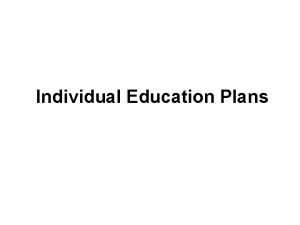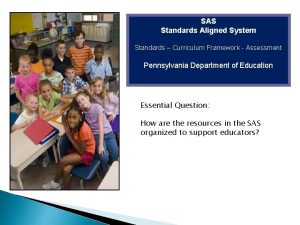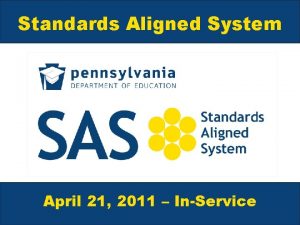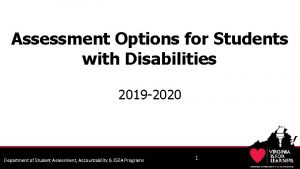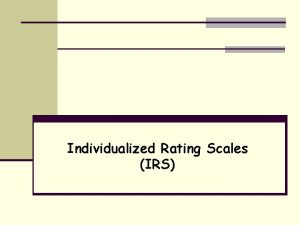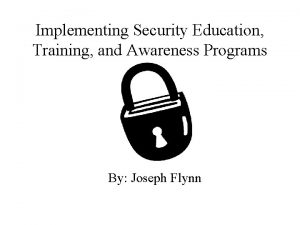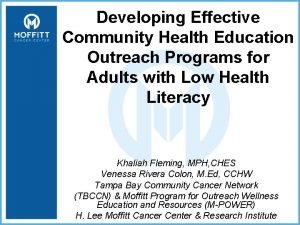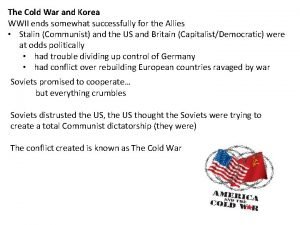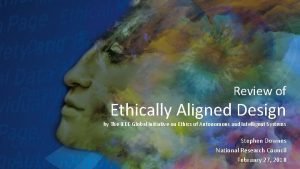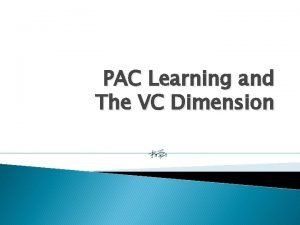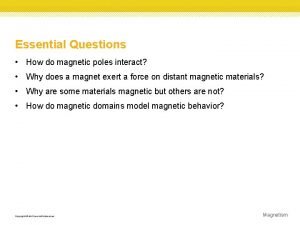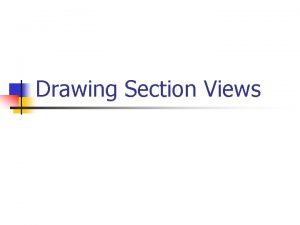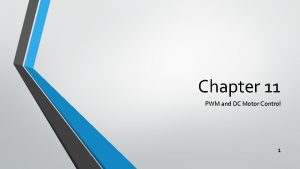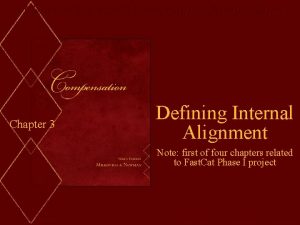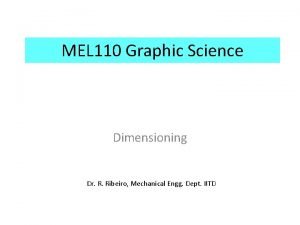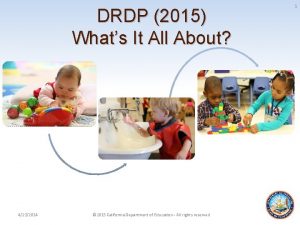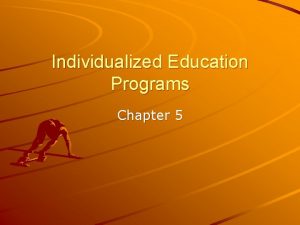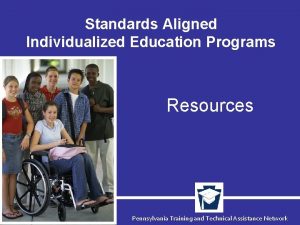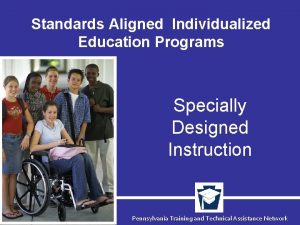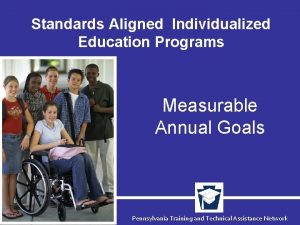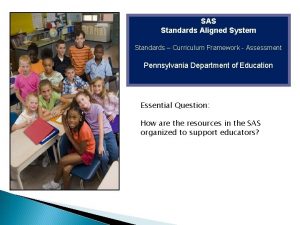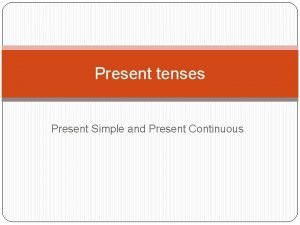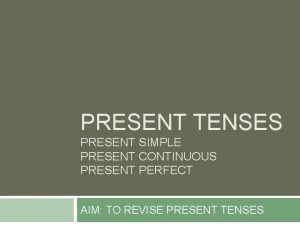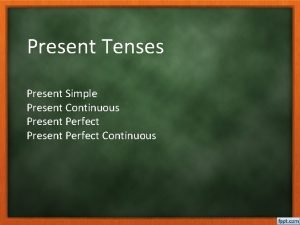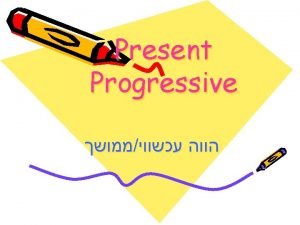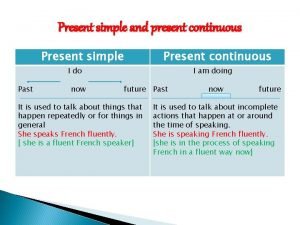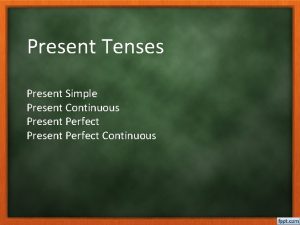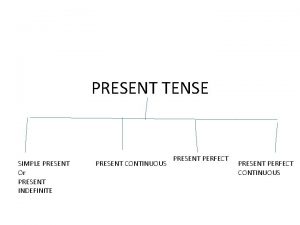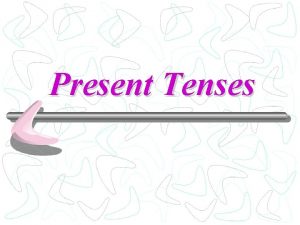Standards Aligned Individualized Education Programs Present Levels of

























- Slides: 25

Standards Aligned Individualized Education Programs Present Levels of Academic Achievement and Functional Performance Pennsylvania Training and Technical Assistance Network

Pa. TTAN’s Mission The mission of the Pennsylvania Training and Technical Assistance Network (Pa. TTAN) is to support the efforts and initiatives of the Bureau of Special Education, and to build the capacity of local educational agencies to serve students who receive special education services. 2

PDE’s Commitment to Least Restrictive Environment (LRE) Our goal for each child is to ensure Individualized Education Program (IEP) teams begin with the general education setting with the use of Supplementary Aids and Services before considering a more restrictive environment. 3

Standards Aligned System Standards-Aligned IEPs Standards Aligned Assessment Progress Monitoring Present Levels of Academic Achievement and Functional Performance Specially Designed Instruction Standards Aligned MAGs 4

Present Levels Provide a summary of baseline data related to academic achievement and functional performance indicating the student’s strengths and needs as well as a description of how the disability effects progress in the general education curriculum 5 5 * Consider the 4 types of assessment 5

Present Levels It is critical that assessment, present levels, goals and progress monitoring include both the instructional and grade levels – Instructional level alone does not meet the criteria of the general education curriculum – Grade level alone does not meet the criteria of an IEP based on identified skill needs 6

Present Levels It is impossible to write clear and measurable annual goals if you don’t have clear and measurable present levels of academic achievement and functional performance. 7

Present Levels Include: • Present levels of academic achievement • Present levels of functional performance • Present levels related to current postsecondary transition goals (if a student is 14, or younger if determined by the IEP team) • Strengths/skills • Parental input and concerns • How student’s disability affects involvement and progress in the general education curriculum and his/her needs 8

Present Levels Must… • Be data driven (measurable and observable) • Provide a starting point (baseline) for development of measurable annual goals • Reference gaps in instructional level vs. grade level standards/expectations • Reference post-school transition goals • Include relevant, useful, understandable and measurable information 9

Present Levels Must… • Incorporate information from all team members • Describe effect of disability on performance • Identify strengths • Prioritize needs • Guide development of other areas of the IEP 10

Let’s Examine… “Jessie’s classroom performance is inconsistent. ” What is meant by classroom performance? • Maintains 3 -ring binder of study guides for each core academic class What is meant by inconsistent? • Ranges from 1 – 8 missing guides per week Put it all together for a clearer statement: “Jessie maintains study guides for her academic classes, and averages 4 missing guides per week. ” 11

Pennsylvania Training and Technical Assistance Network

Present Levels Sample Data – Sample Items: • Pennsylvania System of School Assessment (PSSA) • Pennsylvania System of School Assessment – Modified (PSSA-M) • Pennsylvania Alternate State Assessment (PASA) • Pennsylvania Value-Added Assessment System (PVAAS) • Keystone Exams • 4 Sight • Dynamic Indicators of Basic Early Literacy Skills (DIBELS Next) • Group Mathematics Assessment and Diagnostic Evaluation (GMADE) • Group Reading Assessment and Diagnostic Evaluation (GRADE) • • • Student work samples Career inventories Grades (report card) Curriculum-Based Assessment (CBA) Specific skills assessment Progress monitoring in content areas related to reading, mathematics, writing Previous years’ IEP W-APT (ESL Assessment) ACCESS for ELLs (ESL Assessment) 13

Present Levels Data – Functional/Other • • • Behavior Attendance Tardy Speech / Language Behavior/social skills • • Occupational Therapy Physical Therapy Vision Support – Students who are Deaf or Hard of Hearing • Daily living skills Note: The above data is critical information for many students; however, today’s focus is on aligning IEPs to state promulgated standards. 14

Your perspective… • What might a student’s PLAAFP look like if all assessments and data were based on instructional level? • What might a student’s PLAAFP look like if all assessments and data were based on grade level? • How can we encourage teachers to include all four types of assessment data? 15

Meet David… Completing his 7 th grade year ( 12 years old) IEP Written for 8 th grade year q Review handout, “David’s Present Levels of Academic Achievement: q Underline or highlight his needs. 16

General Observations: David’s PLAAFP David’s Present Levels in Reading, Writing and Math: Are they. . q Connected to standards? q Descriptive? • strengths, needs, input from teachers q Data types? interpretations of the data? q Summative q Formative q Diagnostic q Benchmark q Instructional level information? q Grade level information? 17

Access to General Education BRIDGE Where they need to be SDI Where they are 18

Prep for the IEP B ring all data R esources I ndividualize! D escribe SDI that works G rade level requirements E nter your suggested Standard Aligned Goals 19

Meet Mary… Completing her 6 th grade year ( 11 years old) IEP Written for 7 th grade year q Review handout, “Mary’s Present Levels of Academic Achievement: q Underline or highlight her needs. 20

General Observations: Mary’s PLAAFP Mary’s Present Levels in Reading and Math: Are they. . q Connected to standards? q Descriptive? • strengths, needs, input from teachers q Data types? interpretations of the data? q Summative q Formative q Diagnostic q Benchmark q Instructional level information? q Grade level information? 21

B R I D G E - sample Student_________Grade ____Subject______ David 8 Reading Summative PSSA 2007 District KTEA Feb 2007 Benchmark 4 Sight Nov & Jan 2008 Item Analysis Di. BELS Strengths Factual Questions, Text features, titles, subtitles, pictures and bold print Instructional 5 th grade 125 WCPM 97%acc. Needs Below Basic 65% in reading skills Below Basic Read Critically in Content Areas Inferences, figurative language 8 th Grade 92 WCPM 46% acc. Diagnostic-Not given this year… Formative Report Cards Teacher Survey Class Assignments English Social Studies Science Health Last Years IEP SDI Passing all classes Science and Health SDI, factual info, Text features, organization Factual Questions 100% acc. English and Social Studies Reading /writing skills Assertions about text Inferences/figurative language 42% acc. Specific skill goals met main idea, text features, narrative elements with 95% acc. Supporting details, cause and effect, paraphrasing, multisyllabic decoding, vocabulary Reciprocal teaching, oral summarizing, word study, preteaching, notetaking concept maps, graphic organizers, word processing All from left. Begin to fade oral summarizing, develop partner work/procedures Prioritize- ask… What skills are needed to close the gap & achieve at or above grade level? Reading Standards 1. 1 Learning to Read Independently C, E, F, G 1. 2 Read Critically in all Content Areas A B 1. 3 Reading, Analyzing and Interpreting Literature B, C, E Standards for Success 1. 1. 8 F Understand the meaning of and apply key vocabulary across various subject areas. 1. 1. 8 G Demonstrate after reading understanding and interpretation of both fiction and non fiction text, including public documents…. 1. 2. 8 A Read and understand essential content of information texts and documents in all academic areas. (inferences) Anchor R 8 A 1. 3. 8 E Analyze drama to determine the reasons for a characters actions taking into account the situation and basic motivation of the character. 22

B R I D G E - sample Student__Mary_____Grade 6___Subject______ Reading Summative PASA 2007 Strengths • Proficient on Level B of Grade 5/6 test. • Reading pictures, reading single words, understanding complex pictures or icons, and listening comprehension • Answers literal ‘who’ and , ‘what questions after listening to a sentence Benchmark AIMSweb • Diagnostic CORE Phonics Survey • Identified 26/26 upper and lower case letter names • Identified 19/21 consonant sounds • Identified 12/15 short vowels in CVC words • Identified 7/15 consonant blends with short vowels Brigance Diagnostic Comprehensive Inventory of Basic Skills Instructional 1 st grade 55 WCPM with 70% accuracy Needs • Answering literal “where”, “when” and “why” questions after listening to a sentence. • Identifies pictures showing ‘main event’ after listening to a story • Prioritize- ask… What skills are needed to access and align with the grade level reading standard? 2 nd grade 70 WCPM with 90% accuracy • Consonant blends Reading Standards 1. 1 Learning to Read Independently B, C, D, 1. 2 Read Critically in all Content Areas E • Identified 150/250 sight words Standards for Success (Alternate Academic Content Standards for Reading) 1. 1. 7. B Use word analysis skills, context clues, knowledge of root words as well as dictionary/thesaurus or glossary…. . (Grade 7/8 1. 1. C) 1. 1. 7 C Use meaning and knowledge of words across content areas to expand reading vocabulary. (Grade 7/8 1. 1. D) 1. 1. 7 D Demonstrate comprehension/understanding before reading, during reading, and after reading on grade level texts through strategies… (Grade 7/8 1. 1. G) 1. 2. 7 E Read and understand essential content of information texts and documents in all academic areas.

B R I D G E – sample - Continued Student__Mary_____Grade 6___Subject______ Reading Formative Teacher Survey Teacher Probes Strengths • Accessing general education curriculum with academic supports • Chooses source of information; points to text features Needs • Respond to the essential content of the text • Identify and use text structures and graphic features to comprehend information. • Weekly probes: 5 literal comprehension questions at end of grade 1 reading passage with 60% accuracy • ‘Where’, ‘when’ and ‘why’ questions Class Assignments • Social Studies • Science • Completes all assignments with peer and/or adult supports Last Years IEP • SDI • Use of word/picture/symbols, text to speech software, use of visuals to preview and acquire new information and build background knowledge, clarification of big idea paired with word/picture/symbol, chunking tasks into manageable parts, providing a template/timeline for completion of activities. Standards for Success Specific skill s goals met: Reading words paired with pictures, in context, in sentences/paragraphs with 90% accuracy in grade 1 reading materials. Prioritize- ask… What skills are needed to access and align with the grade level reading standard? Reading Standards 1. 1 Learning to Read Independently B, C, D • Identifying facts in texts, sequencing events, summarizing, 1. 2 Read Critically in all Content Areas A • All from left • Begin fading out adult supports in preference to peer supports • Increase parts of tasks to complete without assistance (Alternate Academic Content Standards for Reading) 1. 1. 7. B Use word analysis skills, context clues, knowledge of root words as well as dictionary/thesaurus or glossary…. . (Grade 7/8 1. 1. C) 1. 1. 7 C Use meaning and knowledge of words across content areas to expand reading vocabulary. (Grade 7/8 1. 1. D) 1. 1. 7 D Demonstrate comprehension/understanding before reading, during reading, and after reading on grade level texts through strategies… (Grade 7/8 1. 1. G) 1. 2. 7 E Read and understand essential content of information texts and documents in all academic areas.

PLAAFP on the IEP you wrote… • Read the PLAAFP on the IEP you wrote • Highlight the measurable data written • How many different types of assessment do you see referenced? • Check all that apply from the list below: – There are connections to standards – They are descriptive (strengths, needs, input from teachers) – They discuss data and provide interpretations of the data • • Summative Formative Diagnostic Benchmark 25
 Individualized education plan
Individualized education plan Standard aligned system
Standard aligned system Media and information design framework
Media and information design framework Vaap aligned standards of learning 2020-2021
Vaap aligned standards of learning 2020-2021 Cpmcd in software engineering
Cpmcd in software engineering Peter g schultz
Peter g schultz Individualized consideration
Individualized consideration Idealised influence examples
Idealised influence examples Individualized instruction vs differentiated instruction
Individualized instruction vs differentiated instruction Individualized rating scale
Individualized rating scale Individualized family service plan example
Individualized family service plan example Center for individualized medicine
Center for individualized medicine Individualized healthcare
Individualized healthcare Costa house of questions
Costa house of questions Security education and training programs
Security education and training programs Community health education outreach programs
Community health education outreach programs Non aligned countries during cold war
Non aligned countries during cold war Ethically aligned design
Ethically aligned design Vc dimension of axis aligned rectangles
Vc dimension of axis aligned rectangles How do magnetic poles interact
How do magnetic poles interact Sectioning shafts
Sectioning shafts Edge aligned pwm
Edge aligned pwm Standard aligned system
Standard aligned system Strategic choices in internal alignment design
Strategic choices in internal alignment design Aligned dimensioning
Aligned dimensioning Drdp 2015
Drdp 2015
